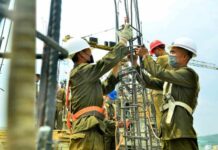[imText1] The first magazine to directly relay inside news from North Korean underground journalists has been launched with the help of Asia Press.
When civilians residing in North Korea directly report on events and write articles, the journalists at “Rimjinkang (Rimjin River)” receive manuscripts and publishes them as a magazine, Rimjinkang. The press conference for the founding of this magazine was held at Seoul Press Center on the afternoon of the 20th.
North Korea journalists who have participated in creating “Rimjinkang” have maintained close ties with Japan’s “Asia Press” for the past five years and have recorded a collection on civilian lives, conducted interviews with local civilians and filmed documentaries from the inside. A significant amount of documentaries on North Korea currently circulating in South Korea and Japan were directly filmed by them.
Parties affiliated with the magazine’s publication said that they will circulate “Rimjinkang” inside North Korea.
30 domestic and international press agencies, including Fuji TV, AP, Reuter, and other prominent global media sources, attended the press conference.
Jiro Ishimaru, a representative of the “Asia Press” Osaka Office in charge of publishing the magazine, said, “It is not an exaggeration to say that North Korea is the world’s most information-closed country. It is absolutely difficult for outsiders to climb this wall and unfold reporting activity in North Korea, so the need for North Korean citizens themselves to record and relay North Korea’s reality has surfaced.”
He emphasized, “Just as the South Korean media fought for democracy in `87, journalism is needed in North Korea to create democracy.”
Further, he added, “The theme that the North Korean reporting team is pursuing is how North Korean citizens are living, what they are thinking, and what they hope for. Only North Korean people can show through evidence how North Korea is changing.”
When North Korean inside reporters deliver articles to the outside through border contacts, they articles are forwarded to the Osaka office of “Asia Press. The manuscript is issued after being proofread by defector Choi Jin I (Editor-in-Chief), who was formerly a member of the North Korean Writer’s Alliance.
[imText2]Currently, there are 10 North Korean journalists associated with “Rimjinkang.” The roster (in their pan names) of North Korean journalists introduced in the publication is Gye Myung Bin (Central Enterprise Leader), Gong Young Gil (a teacher in his 30s), Ryu Kyung Won (a laborer at a foreign-currency earning company), Lee Jun (a journalist who is releasing his pan name to outside for the first time), Baek Hyang (a woman in her 40s residing in Pyongan Province), and Shin Do Suk (a journalist in his 30s residing in South Hamkyung Province).
Representative Ishimaru said at the press conference, “We have interviewed around 600 defectors along the Chinese-North Korean border. Several among them were interested in relaying North Korea’s insider news to the outside community via media, so we began educating them in journalism in 2002.”
“We explained what ‘journalism’ is and taught them the techniques for using a video camera and for formatting articles. They began reporting after returning to North Korea, and since 2004, a portion of the results have been circulated in Japan, South Korea, Europe, and the U.S.”
He added, “Throughout the process we received suggestions from the North Korean reporters themselves to create a medium that publicizes in greater detail the contents of their reporting, so we began serious discussions early this year and decided to launch a bimonthly magazine.”
The “Rimjinkang,” which was publicized in Korean on the 20th, is expected to be launched in English and Japanese within the year.
The first issue contains contents regarding civilian sentiment after the firing of missiles by North Korea last year, interviews with central enterprise leaders regarding North Korea’s economic situation, an explanation of the situation inside North Korea, and a briefing of local North Korean events and incidents.
At the press conference, reporter Lee Jun’s 10-minute footage of Pyongyang immediately following the flood in August was shown. The video footage contained images such as Pyongyang’s Nakrang, Sunkyo, and Ryukpyo Regions and Pyongyang civilians dealing in the markets.
Representative Ishimaru explained, “Through the video footage, we can see civilian lives which are completely different from the Pyongyang we have seen until now. We can see that the civilians are living in a market economy.”

















